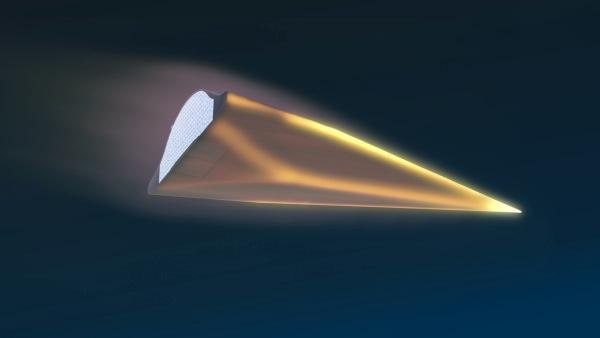Wed, Aug 24, 2011
Flight 1 Engineering Changes Believed Effective
During a test flight Thursday, 11 August, DARPA's Falcon HTV-2
scramjet powered aircraft experienced a flight anomaly post perigee
and into the vehicle's climb. The anomaly prompted the vehicle's
autonomous flight safety system to use the craft's aerodynamic
systems to make a controlled descent and splash down into the
ocean, according to a DARPA news release. Controlled descent is a
term typically associated with a human-in-the-loop directing or
guiding the unscheduled landing of an aircraft. For DARPA's
Hypersonic Technology Vehicle 2 (HTV-2) controlled descent takes on
new meaning thanks to the vehicle's safety system.

"We've confirmed that the HTV-2 made impact with the Pacific
Ocean along its flight trajectory as planned in the event of an
anomaly," explained Air Force Maj. Chris Schulz, DARPA HTV-2
program manager and PhD in aerospace engineering. "This flight
safety system is a significant engineering advance in that the
system prompts a vehicle to monitor the parameters under which it
is operating and exercise safety protocols completely autonomously
should those parameters be breached."
"According to a preliminary review of the data collected prior
to the anomaly encountered by the HTV-2 during its second test
flight," said DARPA Director Regina Dugan, "HTV-2 demonstrated
stable aerodynamically controlled Mach 20 hypersonic flight for
approximately three minutes. It appears that the engineering
changes put into place following the vehicle's first flight test in
April 2010 were effective. We do not yet know the cause of the
anomaly for Flight 2."
A detailed analysis conducted by an independent Engineering
Review Board following the first flight test, prompted engineers to
adjust the vehicle's center of gravity, decrease the angle of
attack flown and use the onboard reaction control systems to
augment vehicle flaps during the vehicle's second flight test.
Those changes appear to have been effective. "An initial assessment
indicates," said Schulz, "that the Flight 2 anomaly is unrelated to
the Flight 1 anomaly."
More News
He Attempted To Restart The Engine Three Times. On The Third Restart Attempt, He Noticed That Flames Were Coming Out From The Right Wing Near The Fuel Cap Analysis: The pilot repor>[...]
Make Sure You NEVER Miss A New Story From Aero-News Network Do you ever feel like you never see posts from a certain person or page on Facebook or Instagram? Here’s how you c>[...]
From 2009 (YouTube Edition): Leading Air Show Performers Give Their Best Advice for Newcomers On December 6th through December 9th, the Paris Las Vegas Hotel hosted over 1,500 air >[...]
Aero Linx: NASA ASRS ASRS captures confidential reports, analyzes the resulting aviation safety data, and disseminates vital information to the aviation community. The ASRS is an i>[...]
“For our inaugural Pylon Racing Seminar in Roswell, we were thrilled to certify 60 pilots across our six closed-course pylon race classes. Not only did this year’s PRS >[...]
 NTSB Final Report: Rutan Long-EZ
NTSB Final Report: Rutan Long-EZ ANN FAQ: Turn On Post Notifications
ANN FAQ: Turn On Post Notifications Classic Aero-TV: ICAS Perspectives - Advice for New Air Show Performers
Classic Aero-TV: ICAS Perspectives - Advice for New Air Show Performers ANN's Daily Aero-Linx (06.28.25)
ANN's Daily Aero-Linx (06.28.25) Aero-News: Quote of the Day (06.28.25)
Aero-News: Quote of the Day (06.28.25)



